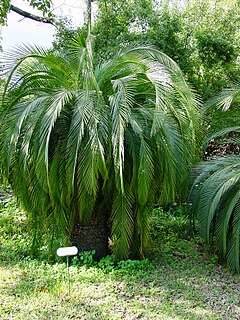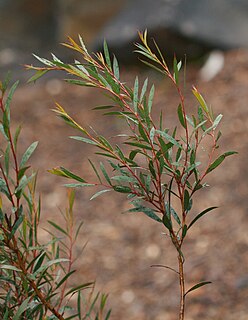
The Haast's eagle is an extinct species of eagle that once lived in the South Island of New Zealand, commonly accepted to be the Pouakai of Maori legend. The species was the largest eagle known to have existed. Its massive size is explained as an evolutionary response to the size of its prey, the flightless moa, the largest of which could weigh 230 kg (510 lb). Haast's eagle became extinct around 1400, after the moa were hunted to extinction by the first Māori.

Crinum is a genus of about 180 species of perennial plants that have large showy flowers on leafless stems, and develop from bulbs. They are found in seasonally moist areas, including marshes, swamps, depressions and along the sides of streams and lakes in tropical and subtropical areas worldwide.

Nothofagus moorei, commonly known as Antarctic beech, is an important Gondwana relict of the rainforests of the southern hemisphere. It occurs in wet, fire-free areas at high altitude in eastern Australia.

Macrozamia moorei is a cycad in the family Zamiaceae, native to Queensland (Australia).

Shijimia moorei, the Moore's Cupid, is a small butterfly found in India that belongs to the lycaenids or blues family. It is found from Assam to Indo China and Japan.

The motorbike frog is a frog well known in Southwest Australia. It is a ground-dwelling tree frog of the family Hylidae, one of only three species of hylids occurring in that region. Its common name comes from the male frog's mating call, which sounds similar to a motorbike changing up through gears; it is also known as Moore's frog, the western bell frog, western green and golden bell frog, and western green tree frog.

The Chilean moth is a moth of the family Cossidae. The butterworm is the larval form and is commonly used as fishing bait in South America.
Solobacterium moorei is a bacterium that has been identified as a contributor to halitosis. It is a gram-positive anaerobic bacillus, erroneously known as Bulleidia moorei, in the family Erysipelotrichaceae of the order Erysipelotrichales. This particular strain was identified by Kageyama and Benno in 2000, previously an unclassified Clostridium group RCA59.

Eucryphia moorei, commonly known as pinkwood, plumwood, or eastern leatherwood is a tree found in southeastern New South Wales, Australia. It also occurs just over the border at the Howe Range in Victoria. Pinkwood is the dominant tree species of cool-temperate rainforests of southeastern NSW. Young plants often grow as hemiepiphytes.

Citronella moorei is a rainforest tree growing in eastern Australia. Common names for this species include churnwood, citronella, soapy box, silky beech, and corduroy.

Ambulyx moorei, the cinnamon gliding hawkmoth, is a moth of the family Sphingidae. The species was first described by Frederic Moore in 1858. It is found in Sri Lanka, southern and eastern India, the Nicobar Islands and Andaman Islands, Thailand, Vietnam, southern China, the Philippines, Malaysia, Singapore and Indonesia.

Dendrobium moorei, commonly known as the drooping cane orchid, is a species of epiphytic or lithophytic orchid in the family Orchidaceae and is endemic to Lord Howe Island. It has cylindrical pseudobulbs, leathery, dark green leaves and between two and fifteen small, white drooping flowers that do not open widely.

Randia moorei, commonly known as the spiny gardenia, is a rare Australian shrub growing in the far north eastern areas of the state of New South Wales and adjacent areas in Queensland. The habitat is subtropical rainforest north of Lismore.

Eucalyptus moorei is a small eucalyptus plant mostly seen growing in the Blue Mountains and southern tablelands region in eastern New South Wales.

Comboyne is a village on the Mid North Coast region of New South Wales. It is situated on the Comboyne Plateau, some 60 km south-west of Port Macquarie, 35 km west of Kew and 54 km north-west of Taree. It is an attractive agricultural area with fertile soils and a high rainfall. The word "Comboyne" is a corruption of the local Biripi people's name for "a place of kangaroos" (Gambuyn). At the 2011 census, Comboyne had a population of 453.
Karanasa moorei is a butterfly of the family Nymphalidae. It is found in north-western India and Afghanistan.
Cucurbita moorei is a plant species of the genus Cucurbita. It is native to the vicinity of Ixmiquilpan, Mexico. It has dark green leaves with white markings and orange flowers.
Yirrkala moorei is an eel in the family Ophichthidae. It was described by John E. McCosker in 2006. It is a marine, tropical eel which is known from the western central Pacific Ocean, including Marquesas and American Samoa. It dwells at a depth range of 25 to 454 metres. A juvenile male specimen measured a total length of 43.4 centimetres (17.1 in).

Sybra is a genus of beetles in the family Cerambycidae, containing the following species:

Sybra ordinata is a species of beetle in the family Cerambycidae. It was described by Bates in 1873.
















